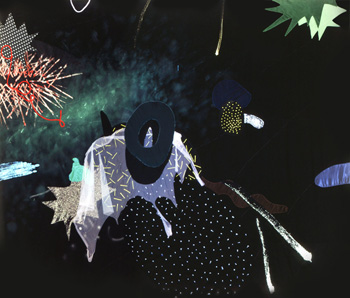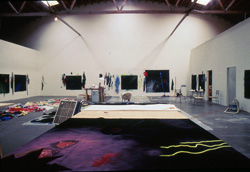Peter Alexander
Velvets 1974- 1982
Resins 2009
Images
| Biography
October 22nd – November 26th, 2011
Reception: October 22nd, 2011 5-7PM
In conjunction with the Getty initiative, Pacific Standard Time: Art in Los Angeles 1945-1980, Craig Krull Gallery will present an exhibition of Peter Alexander’s Velvets from 1974-1982, and Resins from 2009.
Considered one of the key figures in the L.A. Light and Space movement, Alexander first exhibited his seminal cast polyester resin works in his graduate exhibition at UCLA in 1966. His highly polished, translucent and subtly toned cubes, wedges and wall pieces have inspired comparisons to the West Coast milieu of surfboards and metallic auto bodies, but more specifically, they manifest the artist’s fascination with light, luminosity and a state of suspended liquid space. While the term, Finish Fetish was often applied to this type of work, the slick surface is more a point of entry than an end in itself. The exhibition at Craig Krull Gallery will include a selection of recent resin works from 2009.
Since the 1960s, Alexander has continued to explore the relationships of light, surface and space in L.A.’s nighttime grid of lights, sunsets, swimming pools, oceans and icebergs. One of his most adventurous, and now landmark, bodies of work, Velvets, was inspired by an overnight fishing trip off the coast of California. Observing the crew catching bait in the middle of the night, Alexander wrote,
“You could smell the desert in the air, carried by the wind from the coast. The red tide was going strong that September, so the sea was fluorescent with those tiny organisms. To attract squid to the boat, the fishermen placed a very powerful light on the end of a davit that was swung out over the water. It cast an arc of light some 60 feet in diameter. Everything beyond its arc lay in blackness, you couldn’t distinguish the sea from the sky; there was no horizon. Within the arc of light was a clear, brilliant emerald green world of water. Thousands of squid swam to the light,like moths to a porch lamp, in layers of pink, transparent, vibrant, squiggly masses.”
The Velvets are large un-stretched squares and rectangles of black velvet painted in vibrant, glittery acrylic with hand-sewn (by his then wife Clytie Alexander) bits of nylon, silk, gold string, sequins and other dazzling fabrics. In a 1981 review, Christopher Knight wrote, “Suspended between surface and distance, the velvets become lush, underwater jungles of floating anemones, tropical fish and exotic creatures.” Commenting of the unusual choice of velvet as a painting surface, Knight noted, “They take the lowest of low-art media – those cheesy paintings on black velvet for sale at every abandoned gas station from here to Tijuana – and transform it into an ecstatic world.”



